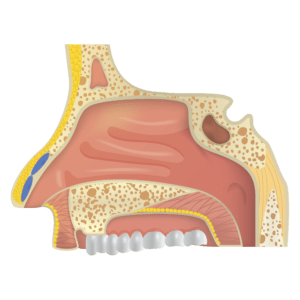Addiction | 4 min read
What Does Cocaine Do To Your Nose?Understanding Coke Nose
Medically Reviewed By

On August 30, 2024
Written By
On March 30, 2022

What you will learn
- Cocaine is a stimulant drug that has many adverse health effects, including damage to the nose – “coke nose.”
- Coke nose is a term used to describe the damage and health problems associated with snorting cocaine.
- Coke nose can range from inflammation and sores to tissue death and a septum perforation or collapse.
- Treatment for cock nose depends on the extent of the damage but may require plastic surgery.
- Addiction treatment is a crucial part of preventing coke nose symptoms from worsening.
Cocaine is a potent stimulant drug that can have devastating effects on the body, including damaging the nose when it’s snorted. The deterioration of the nasal passages with repeated cocaine use is known as “cocaine nose” or “coke nose.”
Learn more about coke nose, its causes and symptoms, and treatment options for cocaine’s damage to the nose.
What Is Coke Nose?
Cocaine use causes constriction of the blood vessels. When you snort cocaine through the nose, it causes the blood vessels in the nasal lining to close, restricting blood flow to the tissue.[1] If the blood flow is restricted for long periods – as with prolonged and repeated cocaine use – the tissue can die. This causes sores in the nasal lining, infection of the supporting cartilage, scarring, and possible septum perforation. In severe cases, the nose may collapse.[2]
Why Does Cocaine Ruin Your Nose?
Cocaine causes nasal irritation in many different ways, including:
Irritating the Thin, Delicate Lining
The nose’s lining isn’t tough like the rest of the body. It’s mucosa, a moist tissue covered in secretions. The skin closest to the nostrils is the thickest and toughest of the nasal lining, but it gets thinner and more delicate as you move back toward the throat.
The Acidic Content of Cocaine
Cocaine once had legitimate medical uses and was tested with a neutral pH. However, illicitly produced cocaine is often acidic, possibly due to contaminants that are used in the process. According to a study, the average pH of tested cocaine samples was 3.5, which is about as acidic as grapefruit juice.[3]
Irritation from Crystals
Snorting cocaine is usually done with something inserted into the nostril, such as a dollar bill or a straw, which can irritate the lining. The powder itself can also be irritating. Though it seems soft, the edges of the small crystals are rough and damage the delicate lining of the nose.
Restricted Blood Flow
Cocaine is a vasoconstrictor, causing the blood vessels to tighten and narrow. This restricts blood flow, which is necessary to keep tissues alive, feed cells, and repair wounds. Snorting cocaine reduces the amount of blood flow to the nasal lining, causing it to become damaged and potentially leading to tissue death.
Possible Contamination
Illicit cocaine is dangerous enough, but you may not know exactly what you’re snorting. There may be substances in the cocaine, such as fentanyl, a potent opioid. This not only increases the risk of overdose but may add to the irritation in your nose if you snort these drugs.
What Happens to Your Nose When You Snort Cocaine?
Several possible complications can occur when you snort cocaine:
Cocaine Nosebleed
Cocaine irritates the nasal lining and dries out the tissue, making your nose susceptible to irritation and inflammation. Nosebleeds from cocaine can be mild to severe, sometimes requiring medical intervention to stop the bleeding. Continuing to use cocaine also impedes healing, leading to more irritation and bleeding.
Nasal Perforation
With prolonged cocaine abuse, the damage to the nasal septum gets worse and worse. Eventually, perforations (holes) can form in the septum. Nasal perforations can be uncomfortable and may cause symptoms like chronic nasal congestion, difficulty breathing, and a whistling sound while breathing. Septal perforations may be visible on the nose and cause a deviated septum in severe cases.
Saddle Nose
A saddle nose deformity, or a nasal collapse, is a condition characterized by a depression or collapse of the bridge of the nose. This gives the nose a flattened appearance that resembles a saddle.
Saddle nose from cocaine abuse can result in many other uncomfortable symptoms, including nasal congestion, difficulty breathing, recurrent nosebleeds, scabbing, and crusting.[4]
Sinus Infections
Cocaine is a harsh substance that can irritate the delicate nasal tissues. Over time, this irritation can lead to inflammation and nasal sores or ulcers, which are likely to bleed. The nasal lining is also designed to prevent foreign particles from entering your body, which it can’t do effectively if dry and irritated. This can lead to frequent sinus infections.
Warning Signs of Coke Nose
The initial signs of a coke nose are often subtle, such as frequent nosebleeds, nasal congestion, and a persistent runny nose. However, more significant symptoms will start as the damage worsens, including:
- Difficulty breathing through the nose
- Visible changes in the nose’s appearance
- Whistling sounds while breathing
- A loss of the sense of smell
- Nasal crusting or scabbing
Treatment for Coke Nose
Treating the damage to a coke nose depends on how far it has progressed. In the early stages, treating the irritation with nasal irrigations or steroids can heal the damage and prevent it from worsening.
If the nasal damage has affected the nose’s appearance, reconstructive surgery may be necessary to restore proper breathing and improve the nose’s appearance. This involves a plastic surgeon performing invasive surgeries to reshape or rebuild the nasal structures.[5] Depending on the extent of the damage, this may take several surgeries.
Treating Cocaine Abuse and Addiction
Any intervention to treat coke nose won’t help if you continue using cocaine. Your nose needs an opportunity to heal without further damage, which can’t happen if you snort cocaine frequently.
If you’re struggling with cocaine addiction or experiencing the symptoms of coke nose, it’s crucial to seek help as soon as possible. Medical detox is often the first step to help with cocaine withdrawal, which can be extremely uncomfortable.
Once withdrawal and detox are complete, you can start an addiction treatment program to manage the underlying causes of addiction and develop healthier habits. While the specifics of each treatment plan vary, this may include support groups, individual and group counseling, and behavioral therapies.
Prevent Coke Nose with Addiction Treatment
Cocaine is highly addictive and has many negative effects on the body, including nose damage that worsens the longer you use the drug. Getting help for cocaine abuse can help you overcome your addiction before you experience adverse effects like overdose or coke nose.
Frequently Asked Questions About Coke Nose
Cocaine is a powerful vasoconstrictor that tightens the blood vessels. When you snort cocaine, it impacts the blood flow of the nasal tissues, leading to nasal sores and ulcers, chronic irritation of the nasal lining, and, eventually, tissue death or erosion.
Cocaine can block your nose in a few different ways. When the blood flow is restricted, it can cause swelling, leading to a blocked or stuffy feeling. Chronic cocaine use leads to swelling of the nasal passages and prolonged nasal congestion.
Yes, cocaine use can increase the risk of sinus infections by impacting the normal function of the nasal passages and sinuses. This creates an environment where bacteria and fungi can thrive.
Cocaine itself doesn’t cause snoring, but the effects of nasal swelling, blockages, and damage can cause or worsen snoring. The swelling and irritation obstruct airflow, leading to snoring or exacerbating existing snoring problems. Chronic use can also cause structural changes that affect breathing patterns, contributing to snoring.
Ascendant New York Editorial Guidelines
Here at Ascendant New York, we understand the importance of having access to accurate medical information you can trust, especially when you or a loved one is suffering from addiction. Find out more on our policy.
[1] Bachi, K., Mani, V., Jeyachandran, D., Fayad, Z. A., Goldstein, R. Z., & Alia-Klein, N. (2017, July). Vascular disease in cocaine addiction. Atherosclerosis. Retrieved from https://www.ncbi.nlm.nih.gov/pmc/articles/PMC5757372/ on 2024, July 25.
[2] BBC. (2023, March 9). Patients face losing noses due to cocaine use, medics warn. BBC News. Retrieved from https://www.bbc.com/news/uk-scotland-glasgow-west-64901125 on 2024, July 25.
[3] M;, C. D. (n.d.). Fire in the vein: Heroin acidity and its proximal effect on users’ health. The International journal on drug policy. Retrieved from https://pubmed.ncbi.nlm.nih.gov/26077143/ on 2024, July 25.
[4] (n.d.). What is a saddle nose deformity?. Cleveland Clinic. Retrieved from https://my.clevelandclinic.org/health/diseases/24978-saddle-nose on 2024, July 25.
[5] FA;, M. D. (n.d.). Reconstruction of the nose damaged by cocaine. Plastic and reconstructive surgery. Retrieved from https://pubmed.ncbi.nlm.nih.gov/11214057/ on 2024, July 25.





